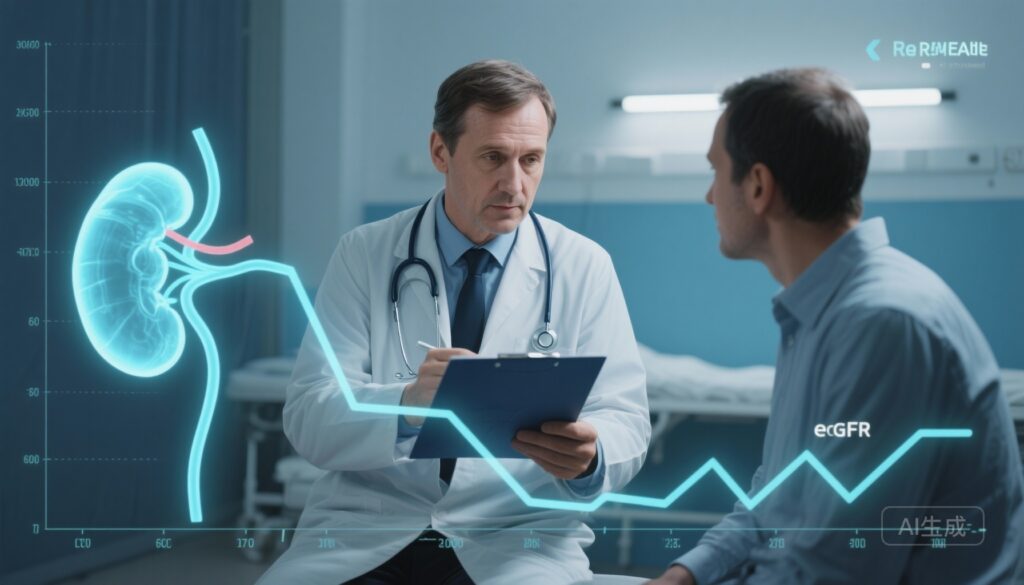Highlights
– Meta-analysis of 10 randomized placebo-controlled trials (SMART‑C; n=70,361) finds SGLT2 inhibitors lower CKD progression by ~38% (HR 0.62) and kidney failure by ~34% (HR 0.66).
– Benefits were consistent across baseline eGFR categories including eGFR <30 mL/min/1.73 m2 (stage 4 CKD) and across UACR ranges including normoalbuminuria (≤30 mg/g).
– SGLT2 inhibitors slowed the annual eGFR decline in all subgroups and showed consistent direction of effect in participants with and without diabetes.
Background and disease burden
Chronic kidney disease (CKD) affects hundreds of millions globally and is a major driver of cardiovascular morbidity, kidney failure, and healthcare costs. Historically, renin–angiotensin system (RAS) blockade has been the cornerstone of slowing CKD progression, with benefit greatest in patients with higher albuminuria. Sodium–glucose cotransporter 2 (SGLT2) inhibitors were developed as glucose-lowering agents but, over the past decade, have shown reproducible cardiorenal benefits beyond glycemic control. Early randomized trials demonstrated renal protection in selected populations; uncertainty persisted about efficacy in patients with advanced CKD (stage 4, eGFR <30 mL/min/1.73 m2) and in those with little or no albuminuria.
Study design and methods
The SGLT2 Inhibitor Meta‑Analysis Cardio‑Renal Trialists’ Consortium (SMART‑C) pooled individual-trial and trial-level data from randomized, double‑blind, placebo‑controlled SGLT2 inhibitor trials that met prespecified criteria (label indication for reducing CKD progression, ≥500 participants per arm, ≥6 months follow-up). Ten trials contributed, totaling 70,361 participants with mixed indications (type 2 diabetes, CKD, heart failure). Primary kidney outcome was CKD progression, defined as kidney failure, ≥50% decline in eGFR, or death due to kidney failure. Secondary outcomes included annual eGFR slope and kidney failure alone. Treatment effects for individual trials were combined using inverse variance–weighted meta-analysis. Subgroup analyses were prespecified for baseline estimated glomerular filtration rate (eGFR) and urinary albumin-to-creatinine ratio (UACR).
Key findings
Population: Mean age 64.8 years; 35.0% female. Across the pooled cohort there were 2,314 CKD progression events (3.3%) and 988 kidney-failure events (1.4%).
Primary kidney composite outcome (CKD progression)
SGLT2 inhibitor therapy reduced the risk of CKD progression from 40.3 to 25.4 events per 1,000 patient‑years (hazard ratio [HR] 0.62; 95% CI, 0.57–0.68). The benefit was consistent across baseline eGFR strata:
- eGFR ≥60 mL/min/1.73 m2: HR 0.61 (95% CI, 0.52–0.71)
- eGFR 45 to <60: HR 0.57 (95% CI, 0.47–0.70)
- eGFR 30 to <45: HR 0.64 (95% CI, 0.54–0.75)
- eGFR <30 (stage 4): HR 0.71 (95% CI, 0.60–0.83)
There was no statistically significant trend across eGFR categories (P for trend = .16), indicating a broadly similar relative risk reduction across the spectrum of kidney function. Although point estimates vary, confidence intervals overlap and favor treatment in all eGFR bands, including stage 4 CKD.
Effect by albuminuria (UACR)
SGLT2 inhibitors reduced CKD progression across UACR strata:
- UACR ≤30 mg/g (normoalbuminuria): HR 0.58 (95% CI, 0.44–0.76)
- UACR >30–300 mg/g (microalbuminuria): HR 0.74 (95% CI, 0.57–0.96)
- UACR >300 mg/g (macroalbuminuria): HR 0.57 (95% CI, 0.52–0.64)
P for trend = .49, indicating no clear interaction between baseline albuminuria and relative benefit.
Kidney-failure outcome and eGFR slope
SGLT2 inhibitors also reduced kidney failure alone (HR 0.66; 95% CI, 0.58–0.75). Across all eGFR and UACR subgroups, treatment slowed the annual eGFR decline compared with placebo; this pattern persisted when analyses were stratified by diabetes status, demonstrating benefit in patients with and without diabetes.
Clinical and absolute benefit considerations
Relative risk reductions were clinically meaningful across the population. Absolute benefit will of course vary by baseline risk: patients with lower eGFR or higher albuminuria have higher baseline event rates and therefore larger absolute reductions in events. Importantly, even participants with low baseline albuminuria or stage 4 CKD—a group often excluded from earlier trials or considered less likely to benefit—showed reduced progression rates.
Safety, tolerability, and practical considerations
Although the SMART‑C paper focused on efficacy across kidney strata, established safety data from the SGLT2 program remain relevant. Known adverse effects include an increased risk of genital mycotic infections and, rarely, diabetic ketoacidosis (primarily in insulin-dependent or type 1 diabetes). An initial acute dip in eGFR after SGLT2 inhibitor initiation is typical and generally stabilizes to a slower long-term decline; this hemodynamic effect should not, in most cases, prompt discontinuation. Volume depletion and hypotension may occur, particularly in patients on high-dose diuretics—monitoring and temporary dose adjustments may be necessary. Importantly, glycemic efficacy declines with lower eGFR, but cardiorenal protection persists, supporting use for organ protection independent of glucose lowering.
Expert commentary and biological plausibility
These findings align with a growing mechanistic and clinical literature. Mechanisms by which SGLT2 inhibitors protect the kidney include restoration of tubuloglomerular feedback leading to reduced intraglomerular pressure; natriuresis and blood pressure lowering; improved metabolic milieu; reductions in renal inflammation, hypoxia, and fibrosis; and favorable hemodynamic and neurohormonal effects. The consistency across eGFR and UACR suggests multiple convergent mechanisms beyond simple glycemic control.
From a clinical-policy perspective, the SMART‑C meta-analysis strengthens the argument for broadening SGLT2 inhibitor use to patients at high risk of CKD progression irrespective of baseline albuminuria or stage of kidney impairment, while remaining attentive to regulatory labeling and individual safety considerations.
Limitations and generalizability
Key limitations include heterogeneity across contributing trials in enrollment criteria, background therapies, and endpoint ascertainment. Though the meta-analysis pooled large numbers, the absolute number of events in some subgroups (notably very low eGFR without albuminuria) remains limited, and trials differ in representation of non‑white populations and women. Outcomes and safety were trial-based and may not wholly reflect routine practice, where adherence and comorbidity interplay differ. Finally, regulatory labeling varies by agent and jurisdiction; clinicians must balance trial evidence with local prescribing guidance.
Clinical implications and practice recommendations
For clinicians managing patients with type 2 diabetes, CKD, or heart failure, this meta-analysis provides robust evidence that SGLT2 inhibitors reduce CKD progression and kidney failure across the full range of baseline kidney function and albuminuria. Practical steps include:
- Consider initiating or continuing SGLT2 inhibitors in eligible patients at risk for CKD progression, even when eGFR is in the stage 4 range, after evaluating potential risks and local labeling.
- Anticipate an early eGFR dip (usually small and transient) and monitor renal function and volume status; do not reflexively stop therapy unless the decline is clinically concerning.
- Continue RAS blockade when tolerated—SGLT2 inhibitors are additive to RAS inhibition for renal protection.
- Monitor for known AEs (genital infections, volume depletion, ketoacidosis in susceptible patients) and provide anticipatory counseling.
Research and policy gaps
Remaining questions include optimal initiation thresholds under different regulatory labels, long‑term safety in advanced CKD beyond trial follow-up, real-world effectiveness in underrepresented populations, and head‑to‑head comparisons among SGLT2 drugs. Implementation research to improve equitable access and uptake is important because the greatest absolute benefits accrue in high‑risk populations who often face barriers to care.
Conclusions
The SMART‑C meta‑analysis (Neuen et al., JAMA 2025) synthesizes extensive randomized trial evidence to show that SGLT2 inhibitors reduce CKD progression and kidney failure across eGFR and albuminuria strata, including in stage 4 CKD and patients with minimal albuminuria. These results support broader use of SGLT2 inhibitors for kidney protection, informed by individual patient factors and regulatory guidance, and underscore the class’s transformative role in nephrology and cardiometabolic care.
Funding and clinicaltrials.gov
The SMART‑C consortium meta-analysis cites trial funding and disclosures within each included trial. Individual trials had varied industry and public support; readers should consult original trial publications for specific funding and conflict-of-interest details. ClinicalTrials.gov identifiers and detailed trial protocols are available in the original trial publications referenced below.
References
1. Neuen BL, Fletcher RA, Anker SD, et al; SGLT2 Inhibitor Meta‑Analysis Cardio‑Renal Trialists’ Consortium (SMART‑C). SGLT2 Inhibitors and Kidney Outcomes by Glomerular Filtration Rate and Albuminuria: A Meta‑Analysis. JAMA. 2025 Nov 7. doi:10.1001/jama.2025.20834. PMID: 41203232.
2. Perkovic V, Jardine MJ, Neal B, et al. Canagliflozin and Renal Outcomes in Type 2 Diabetes and Nephropathy. N Engl J Med. 2019;380(24):2295–2306. (CREDENCE trial)
3. Heerspink HJL, Stefánsson BV, Correa‑Rotter R, et al. Dapagliflozin in Patients with Chronic Kidney Disease. N Engl J Med. 2020;383(15):1436–1446. (DAPA‑CKD)
4. Heerspink HJL, Desai M, Kitzman DW, et al. Empagliflozin and Kidney Outcomes in Patients with Chronic Kidney Disease. N Engl J Med. 2023; (EMPA‑KIDNEY).
5. Zelniker TA, Wiviott SD, Raz I, et al. SGLT2 inhibitors for primary and secondary prevention of cardiovascular and renal outcomes in type 2 diabetes: systematic review and meta‑analysis. Lancet. 2019;393(10166):31–39.
6. KDIGO. Clinical Practice Guideline for Diabetes Management in Chronic Kidney Disease. Kidney Int. 2022. (Guideline statements on kidney protection evolve as new evidence emerges.)
Note: Readers should consult individual trial reports for detailed inclusion criteria, safety analyses, and trial-specific clinical recommendations.



